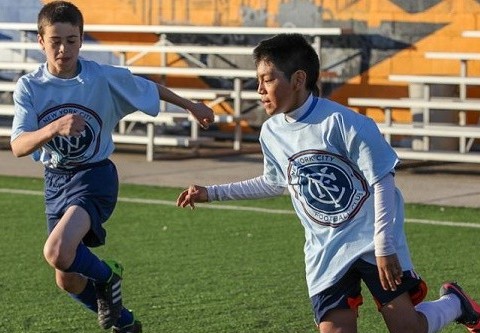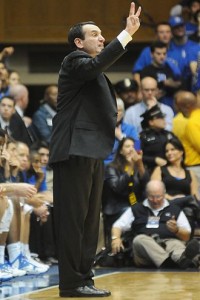Dougherty: Over-coached college basketball can’t measure up to The Beautiful Game
 After the World Cup, the NCAA college basketball tournament is my favorite sporting event. The Sunday Selection Show is must-see television, and watching the Thursday night first-round games is an annual event featuring multiple platters of Chinese food and the hopes of witnessing a No. 3 seed getting sent home early.
After the World Cup, the NCAA college basketball tournament is my favorite sporting event. The Sunday Selection Show is must-see television, and watching the Thursday night first-round games is an annual event featuring multiple platters of Chinese food and the hopes of witnessing a No. 3 seed getting sent home early.
But as a soccer coach and player, I take issue with one aspect of the tournament: the relentless sideline histrionics from way too many of the coaches.
Soccer and basketball have several things in common. Dribble penetration is a crucial skill, for example, and the off-the-ball movement to create passing lanes or space to shoot are fundamental to both games. And like soccer, basketball demands strong individual skills, particularly passing, shooting and defending.
But one stark difference is the role of the coach on the sideline.
For the competitive soccer coach, it is at practice – not games – that the coaching gets done. The United  States Youth Soccer Association and National Soccer Coaches Association of America – the nation’s two most prominent sources of coaching education – emphasize that the game is the player’s domain.
States Youth Soccer Association and National Soccer Coaches Association of America – the nation’s two most prominent sources of coaching education – emphasize that the game is the player’s domain.
Both organizations stress the need for coaches to have structured practices with specific goals in mind. Whether the session is designed to teach technical skills, tactical awareness or both, it must have a purpose, often building from simple to complex.
During these practices, coaches are taught to spot the “teachable moments” to make a correction or applaud something that is done well. Pressure is gradually added during the session to more closely simulate game situations. Focus on two or three key elements to teach, and stick to them throughout the 90-minute practice.
By the end of the session, the coach should be mentally and physically tired.
At game time, coaches are taught to emphasize two or three key offensive and defensive principles, remind the players to use the skills and tactics they learned during the previous weeks practice, then … sit down and watch. The coach’s job is done, at least for the first half.
+READ: Doing the right thing, even when it hurts
Halftime offers opportunities to make some tactical adjustments and talk to some players about things they can do to better dominate their position. But that’s it. The rest is up to the players.

With the exception of Duke coach Mike Krzyzewski and Wisconsin coach Bo Ryan, I don’t recall seeing any college basketball coaches during this year’s tournament just sitting back and letting their teams play.
Two of the worst perpetrators are Michigan State’s Tom Izzo and Kentucky’s John Calipari (and I’m a big Izzo fan!) Former Maryland coach Gary Williams was arguably the worst of all time. He did so much yelling and running along the sideline that he needed to towel off before halftime. I suspect Williams lost a few pounds after every game he coached.
Calipari is constantly running up and down his assigned portion of the court all game, and spends more time on the playing floor than the referees. (I’ve lost track of the number of times I’ve simply stepped on the white line and had the assistant referee give me a polite, but firm, warning to step back).
I’ve seen Izzo yelling at his players to do this or that seemingly each time the opposing team makes a pass. Every now and then I wonder if he has to remind his players to open their eyes, or to breathe.
During all of this, I keep asking myself, “What do these guys do at practice?” After all, if they have to remind their players to raise their hands on defense, or how to make a clean pick, then their practice sessions must be pretty useless.
These are general observations, of course, and there are exceptions. I’ve seen youth soccer coaches do so much yelling during the course of a game, their players must simply tune them out, like a car alarm going off in a shopping mall parking lot. It’s just more background noise that players need to ignore to play effectively. And U.S. Men’s National Team coach Jurgen Klinsmann doesn’t sit down every moment of a game.
+READ: For the young player, details matter
(Some years ago I saw a New Jersey girls travel team with three coaches – one for the forwards, one for the midfielders, and one for the defenders. I couldn’t tell if the goalkeeper was jealous at the lack of attention, or thankful.)
And Wisconsin’s Ryan seldom moves or says a word on the sideline. Incidentally, CBS analyst Bill Raftery described Wisconsin “as the most composed team” in the tournament. Coincidence? I think not.
In the end, I’ve concluded that soccer is a player’s game, and basketball is a coaches game. Soccer is more free-flowing, a dynamic sport in which 22 players are constantly making split-second decisions with each rotation of the ball. Even if a coach wanted to influence what each of his players does, there’s no way he or she can do it.
With its numerous timeouts and emphasis on set plays, basketball is a choreographed competition that requires less individual thinking and creativity and more doing what the coach demands. The coach calls the player, the players run the play. If soccer is The Beautiful Game because of the creativity of the players, then basketball is The Puppet Game as the coach pulls the strings.
March Madness is a lot of fun. But this soccer coach will choose the World Cup every time.
SOCCERWIRE MARKETPLACE
- visitRaleigh.com Showcase Series 2025, hosted by NCFC Youth
- OFFICIAL MANCHESTER CITY SOCCER CAMPS
- Wanted Licensed Youth Soccer Coach
- Join Official Elite Summer Soccer Camps with Europe’s Top Pro Clubs!
- The St. James FC Travel Staff Coach - North (Loudoun) & South (Fairfax)
- The St. James FC Girls Academy (GA) Head Coach - 2 teams
- The St James FC Boys Travel Tryouts
- OFFICIAL BAYERN MUNICH SUMMER CAMPS U.S.
- JOIN THE ALLIANCE!
- OFFICIAL FC BARCELONA CAMPS U.S.











